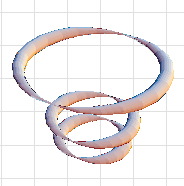Cervical Spine

In the following links a number of biomechanical problems arising from the study of the cervical spine are addressed with the use of quaternion analysis and framed vectors. The various essays are interrelated in such a manner that results obtained in one line of inquiry will have implications for the analysis in several other essays. However, the listings have been arranged so that they tends to move from more fundamental analysis to more specific and more clinical problems as one moves from top to bottom in any listing.
| Geometrical Anatomy? [html | Word doc | PDF] This is a brief essay that addresses the motivation behind the approach that is developed in the other essays. |
|
| Introduction to Quaternions [ Word | PDF ] These essays are very fundamental. They address the basic mathematics that lies at the foundations of the biomechanical analysis presented in the other essays. The other essays assume that the reader is familiar with the basic ideas described in this section. |
|
 |
Upper Cervical Spine; The craniovertebral linkage These essays start with a model that was developed to describe the basic anatomy and biomechanics of the atlanto-occipital and atlanto-axial joints. Then, a series of clinical and biomechanical studies examine the changes in conformation and blood flow in the vertebral arteries as a function of head and neck position. Finally, the role of the alar ligament in the coordination of movements in the craniovertebral junction is described. |
| Lower Cervical Spine The lower cervical spine, which is taken to include the C2/C3 to the C7/T1 intervertebral joints, is explored by developing a model of the anatomy and the consequent biomechanics. The fundamental model is then extended in several directions; considering the implications for the facet joints and the intervertebral discs and how the movements of the lower cervical spine might affect the stresses in the vertebral arteries. |


